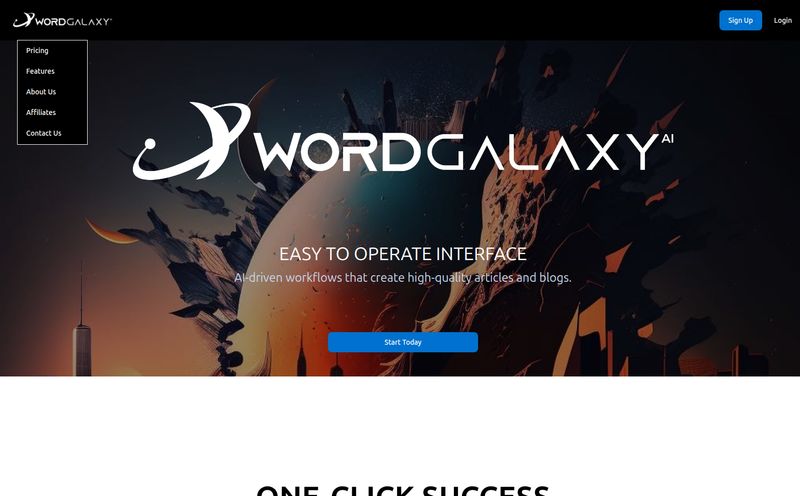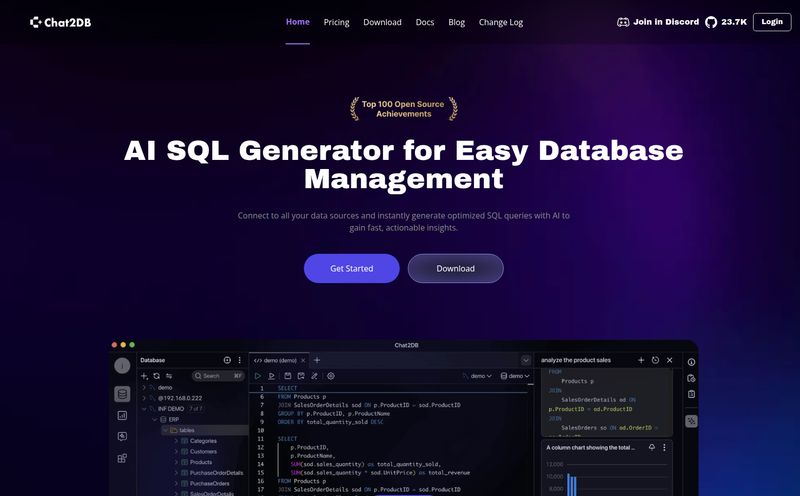You and me. If you’ve been in the SEO or content game for more than a week, you know the drill. You write a brilliant article, source the perfect images, and just as you’re about to hit “publish,” you remember. The alt text.
Ugh. It’s the digital equivalent of being asked to floss. We all know we should do it, we know it's good for us, but man, is it a tedious chore. Especially on a 5,000-word behemoth with 27 images. Or worse, an e-commerce store with thousands of product photos. I still have flashbacks to a project in 2018 where I had to manually optimize alt text for a client’s entire rug catalog. Let’s just say I learned more about Persian knots and jute weaving than I ever wanted to.
So, whenever a tool pops up promising to automate this drudgery, my ears perk up. The latest one to cross my desk is called Altnado. It claims to be an AI-powered solution to this age-old problem. But is it just another flash-in-the-pan AI gadget, or is it a genuinely useful tool for serious marketers? I decided to take a look.
First, A Quick Refresher: Why Alt Text Still Matters
I know, I know, you’re a pro. But let’s just level-set for a second. Alt text (or alternative text) is more than just busywork. It’s a cornerstone of two incredibly important things: SEO and accessibility.
For search engines like Google, alt text provides context for what an image is about. This helps your images rank in Google Image Search (a surprisingly potent traffic source) and tells the algorithm what your page is about, strengthening your overall topical authority. For accessibility, it's non-negotiable. Screen readers use alt text to describe images to visually impaired users, making the web usable for everyone. Neglecting it is not just bad for SEO; it’s bad for people. Simple as that.
So, What's The Deal with Altnado?
In a nutshell, Altnado is a service that automatically generates alt text for the images on your website using AI. The big promise here is that you can set it up by adding a single line of code to your site, and it will crawl your images and write the descriptions for you. No more typing “black dog catching a red frisbee in a park” for the hundredth time.

Visit Altnado
It’s designed to be platform-agnostic, which I really appreciate. It’s not just another WordPress plugin. They list support for everything from Shopify, Wix, and Squarespace to Webflow, Framer, and even custom React or HTML sites. This tells me they're thinking like developers and not just marketers, which is a good sign.
The whole system runs on a credit-based model. One image processed, one credit used. It’s a straightforward approach that feels a lot like how API calls are priced elsewhere.
The Things I Genuinely Like
I'm naturally skeptical of “set it and forget it” solutions, but Altnado has a few things going for it that caught my eye.
The Massive Time-Saving Potential
This is the big one, obviously. Think about a medium-sized e-commerce site launching a new collection with 500 products, each with 3-4 photos. We’re talking about 1,500-2,000 images. Writing unique, descriptive alt text for all of them is a multi-day job for a junior staffer. If a tool can do that in minutes, it's not just saving time; it's saving payroll and freeing up your team to work on strategy, link building, or literally anything more impactful than writing image descriptions.
A Unified Approach to SEO and Accessibility
I love that Altnado doesn't treat these as separate benefits. They are two sides of the same coin. By creating descriptive alt text, you are inherently making your site more accessible and more understandable to search engine crawlers. It’s a win-win, and any tool that helps automate best practices gets a nod from me.
The Reality Check: Potential Downsides
Now, it’s not all sunshine and automated rainbows. As an experienced practitioner, I see a few potential hiccups.
Trusting the AI Overlord
Let's be real: AI is amazing, but it's not a creative director. It can describe what's literally in a photo with stunning accuracy. It can tell you there's a “woman smiling while holding a coffee mug.” What it might miss is that the mug has your new company logo on it, or that the specific type of smile is meant to convey a feeling of 'calm satisfaction' that's central to your brand campaign. For generic blog post images, it's probably fine. For key product images or branded content? I’d still want a human to do a final check. My advice would be to use Altnado for the 80% bulk work and manually polish teh 20% that matters most.
The “Just One Line of Code” Hurdle
To anyone with a technical background, adding a script to the <head> of a website is trivial. But for a solo entrepreneur running their own Squarespace site, that can sound terrifying. It’s definitely easier than manually updating every image, but it's not quite a one-click install for the completely non-technical user. A little bit of bravery (or a friend who knows code) might be required.
Breaking Down the Cost: Altnado's Pricing
So, how much does this convenience cost? Altnado uses a tiered subscription model based on credits per month. Here’s a quick look at their plans:
| Plan Name | Price per Month | Credits per Month | Key Features |
|---|---|---|---|
| Basic | $5 | 100 | Great for small blogs or trying it out. |
| Standard | $19 | 500 | API access included. Good for growing sites. |
| Pro | $49 | 2,000 | For established businesses and agencies. |
| Elite | $99 | 4,000 | Includes priority support. |
| Premium | $199 | 8,000 | For larger scale operations. |
| Ultimate | $399 | 16,000 | Invoice billing and priority support. |
The pricing seems reasonable and scales logically. For a small blogger, $5 to handle up to 100 images a month is a no-brainer. For an agency or a large e-commerce store, the higher tiers offer a cost-effective alternative to paying for someone's time. The inclusion of API access at the $19 Standard tier is also quite generous.
My Final Verdict: Is Altnado Worth It?
So, here’s my take. Altnado is a solid tool that solves a real, nagging problem.
It's not a magic wand that will instantly triple your traffic, but it’s a powerful productivity tool. It’s like a super-smart, tireless intern who handles the most boring part of your job, letting you focus on the stuff that actually requires your human brain—like strategy, creativity, and building connections.
Who should definitely try it?
- E-commerce Managers: Especially on platforms like Shopify. This could be a game-changer for you.
- Content-Heavy Bloggers: If you publish multiple articles a week with lots of images, the time saved will add up fast.
- SEO Agencies: Onboarding a new client and finding they have 5,000 images with no alt text? Altnado could be your new best friend.
Who might want to pass?
- Small Personal Bloggers: If you only post once a month with one or two images, doing it manually is probably still fine.
- Absolute Technophobes: If the idea of touching code gives you hives, you might want to wait for a one-click plugin version (if they release one).
Ultimately, the rise of tools like Altnado is a good thing for our industry. They handle the grunt work, ensuring foundational best practices are met, which frees us up to be more strategic. It's not about replacing the human; it's about augmenting them. And in the endless battle against tedious tasks, I'll take all the help I can get.
Frequently Asked Questions About Altnado
- Is Altnado difficult to install on my website?
- It requires adding a single line of JavaScript code to your website's header. If you're familiar with adding tracking codes like Google Analytics, you'll find it very similar. If not, you might need a little help, but it's a very quick task for anyone with basic web development knowledge.
- How accurate is the AI-generated alt text?
- The AI is generally very good at describing the literal contents of an image. However, it may miss specific branding, emotional nuance, or the strategic intent behind an image. It's best used as a powerful tool to handle the bulk of the work, with a human spot-checking the most important images.
- Does Altnado work with my CMS, like WordPress or Shopify?
- Yes, it's designed to work with most major platforms, including WordPress, Shopify, Wix, Squarespace, Webflow, and more, because it works via a script rather than a platform-specific plugin.
- Is there a free trial for Altnado?
- Yes, the information suggests they offer a free trial that comes with some initial credits, so you can test out the service and see how it works on your site before committing to a paid plan.
- How does the credit system work?
- It's a straightforward system: one credit is used to generate and serve the alt text for one image on your website. Your monthly subscription gives you a set number of credits to use.
- Can the AI write SEO-optimized alt text?
- The AI writes descriptive alt text, which is inherently good for SEO. It describes what's in the image, which provides context for search engines. However, for highly strategic keyword placement within the alt text, you might still want to do some manual tweaking on your most important pages.



